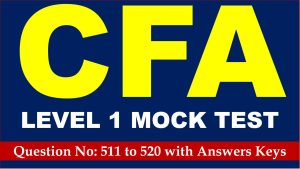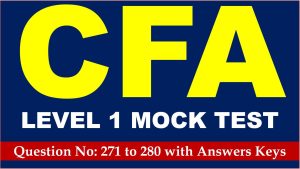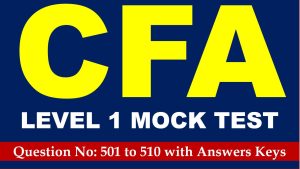Hi CFA Aspirants, welcome to AKVTutorials. Are you preparing for CFA Level 1, 2, 3 exams for making a career in CFA (Charted Financial Analyst). According to CFA Wikipedia, CFA The Chartered Financial Analyst (CFA) program is a postgraduate professional certification offered internationally by the American-based CFA Institute. A candidate who successfully completes the program and meets other professional requirements is awarded the “CFA charter” and becomes a “CFA charter holder”. Therefore, you need CFA Study Notes and Free CFA Level 1 Practice Test 4 Questions Bank Answer Keys AMBIPi.
In this article, you will get Free CFA Level 1 Mock Exam Practice Questions.
Free CFA Level 1 Mock Practice Exam Questions Bank
Free CFA Level 1 Practice Question No: 251:
Standard IV (B.4), Priority of Transactions, suggests implementing “__________” in certain organizations to limit the number of access persons.
Option A : Gag Orders.
Option B : Limit Orders.
Option C : Poison Pills.
Option D : Token Confines.
Option E : Fences.
Option F: Fire Walls.
Option G : Corrals.
Show/Hide Answer
Option F : Fire Walls.
Access or covered persons have knowledge of pending or actual investment recommendations or action. The firm’s definition of access (covered) person should be broad enough to cover all people with that knowledge. Implementing “Fire Walls’ – physical and procedural barriers to prevent the flow of information from one group to another – may be appropriate in certain organizations to limit the number of persons with such access.
CFA Level 1 Exam Question No: 252:
The performance benchmark for a currency overlay portfolio must be calculated in accordance with the portfolio’s mandates, unless the benchmark is the ____________ on a published benchmark.
Option A: tax return.
Option B: cross hedge.
Option C: currency return.
Option D: mean value.
Option E: standard deviation.
Show/Hide Answer
Option C : currency return.
Two portfolios with the same benchmark may give different mandates to the overlay portfolio managers. For example, when the mandate is based on the underlying assets, the return of the overlay performance benchmark will be different unless the underlying assets of two portfolios imply identical currency exposures. Consequently, the performance benchmark for a currency overlay portfolio must be calculated in accordance with the portfolio’s mandates, unless the benchmark is the currency return on a published benchmark.
Free CFA Level 1 Mock Exam Question No: 253:
Which of the following are not required disclosures under the Performance Presentation Standards?
Option A: Portfolio size range and percentage of total assets in the same class.
Option B: The existence of a minimum asset size for the inclusion in composites.
Option C: The inclusion of any non-fee paying portfolios in composites.
Option D: Whether balanced portfolio segments are included in single-asset composites.
Show/Hide Answer
Option A : Portfolio size range and percentage of total assets in the same class.
The existence of a minimum asset size below which portfolios are excluded from a composite must be disclosed. Whether balanced portfolio segments are included in single-asset composites and an explanation of how cash has been allocated among segments must be disclosed. The inclusion of any non-fee -paying portfolios in composites and included in the definition of total firm assets must be disclosed. Only the number of portfolios, their description, the amount of assets in a composite, the percentage of the firm’s total assets the composite represents need be disclosed. The portfolio size range or percentage of total assets in the same class are only recommended, not required disclosures.
CFA Level 1 Free Practice Question No: 254:
Information is ________ until it has been disseminated to the marketplace in general and investors have had an opportunity to react to the information.
Option A: none of these answers.
Option B: walled.
Option C: material.
Option D: inside.
Option E: nonpublic.
Show/Hide Answer
Option E : nonpublic.
Standard V (A) deals with the responsibility of members when they are dealing with the receipt and disclosure of material, nonpublic information. Information is “nonpublic” until it has been disseminated to the marketplace in general and investors have had an opportunity to react to the information. Mere possession of material nonpublic information will trigger trading restrictions under
Standard V (A).
Free CFA Practice Question No: 255:
According to the Standards of Practice Handbook, how frequently should managers gather information on client circumstances, occupation, investment objectives and risk tolerances?
Option A: at least monthly.
Option B: at least annually.
Option C: at least every two years.
Option D: at least every five years.
Show/Hide Answer
Option B : at least annually.
Under Standard IV (B.2), members have a responsibility to consider carefully the needs, circumstances and objectives of the client when determining the appropriateness of a given investment action. In order to provide sound advice, members should gather information on client circumstances, occupation, investment objectives and risk tolerances at the inception of any client relationship and such an inquiry should be repeated at least annually. This will ensure that investment recommendations take into account the diversity and changing nature of portfolio and client characteristics.
CFA Level 1 Sample Question No: 256:
Victor Lazquez is an analyst with Amro Investments and follows the optical instrument manufacturers. In this capacity, he has learnt a few trade secrets pertaining to a leading edge firm, Fibroptica. Recently, he was approached by Fibroptica’s competitor, Lensmakers Inc., who offered him a 3 month project on the optical industry practices. Victor realizes that such a project could reveal Fibroptica’s trade secrets indirectly.
However, he decides he will be very careful and accepts Lensmakers’ offer. If he does not inform his employer about this project, he will
Option A: not have violated any AIMR code since the project does not give rise to a conflict of interest with Amro’s business.
Option B: have violated Standard III (C) – Disclosure of Conflicts to the Employer.
Option C: have violated Standard III (B) – Duty to the Employer.
Option D: have violated Standard III (D) – Disclosure of Additional Compensation Arrangements.
Show/Hide Answer
Option D : have violated Standard III (D) – Disclosure of Additional Compensation Arrangements.
Victor’s knowledge about the trade secrets have arisen in course of his employment with Amro. As such, he has an obligation to get written permission from Amro before he can accept any outside projects. Note that if such a project had been in direct competition with Amro’s business, Victor would also have violated Standard III (B) – Duty to the Employer.
Free CFA Level 1 Quiz Question NO: 257:
Prohibited transactions” are discussed in Standard IV (B.4), Priority of Transactions. Which of the following is NOT suggested as a firm policy?
Option A: None of these answers.
Option B: Participation by investment personnel in equity should be restricted.
Option C: Firms must determine specific requirements relating to blackout period.
Option D: All individuals who are involved in the investment decision-making process should be subject to the same restricted period.
Show/Hide Answer
Option A : None of these answers.
Under the compliance procedures for Standard IV (B.4), members and their firms should clearly define prohibited transactions so that employees completely understand their obligations to clients and their employer.
Participation by investment personnel in equity or equity-based IPOs should be restricted. Also, firm procedures should prevent managers or employees from initiating trades in a security for which their firms have a pending buy or sell order within a 24-hour period. Firms must determine specific requirements relating to such blackout periods. All individuals who are involved in the investment decisionmaking process should be subject to the same restricted period.
Free CFA Level 1 Quiz Question NO: 258:
If senior managers are unwilling to permit dissemination of adverse opinions about a particular corporate client, according to Standard IV (A.3), you should attempt to put that corporate client on a _________.
Option A: holding-pattern.
Option B: restricted list.
Option C: moratorium register.
Option D: none of these answers.
Option E: suspension roster.
Option F: captive list.
Show/Hide Answer
Option B : restricted list.
To avoid violations of Standard IV (A.3), one of the procedures members can enact is to create a restricted list. If senior managers are unwilling to permit dissemination of adverse opinions about a particular corporate client, then the firm should remove the controversial company from the research universe and put it on a restricted list so that the firm disseminates only factual information about the company.
Free CFA Practice Question No: 259:
When formulating an investment policy for a client, which of the following falls under “investor objectives?”
Option A: investable funds.
Option B: time horizon.
Option C: risk tolerance.
Option D: proxy voting.
Option E: liquidity needs.
Option F: none of these answers.
Show/Hide Answer
Option C : risk tolerance.
Risk tolerance is considered under “investor objectives.” Liquidity needs, time horizon, proxy voting and investable funds are considered under “investor constraints.
CFA Mock Exam Free Question No: 260:
Standard III (F) is ____________.
Option A: Responsibilities of Supervisors.
Option B: Disclosure of Conflicts to Employer.
Option C: Obligation to Inform Employer of Code and Standards.
Option D: Disclosure of Additional Compensation Arrangements.
Option E: None of these answers.
Option F: Duty to Employer.
Show/Hide Answer
Option E : None of these answers.
There is no standard III(F)



